Unit 12 Culture Shock Lesson2 Mind Your Manners
文档属性
| 名称 | Unit 12 Culture Shock Lesson2 Mind Your Manners | 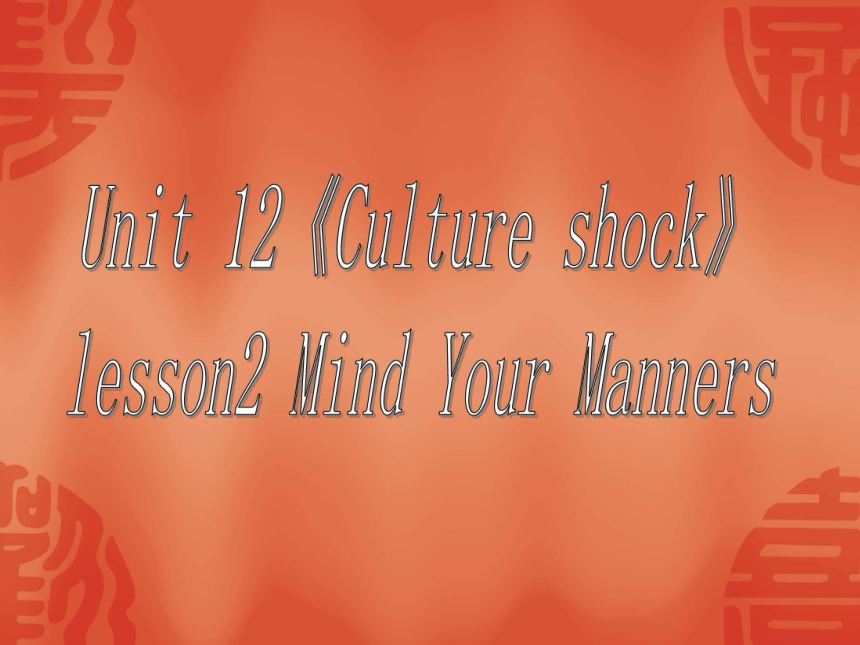 | |
| 格式 | rar | ||
| 文件大小 | 202.5KB | ||
| 资源类型 | 教案 | ||
| 版本资源 | 北师大版 | ||
| 科目 | 英语 | ||
| 更新时间 | 2011-05-25 21:11:08 | ||
图片预览


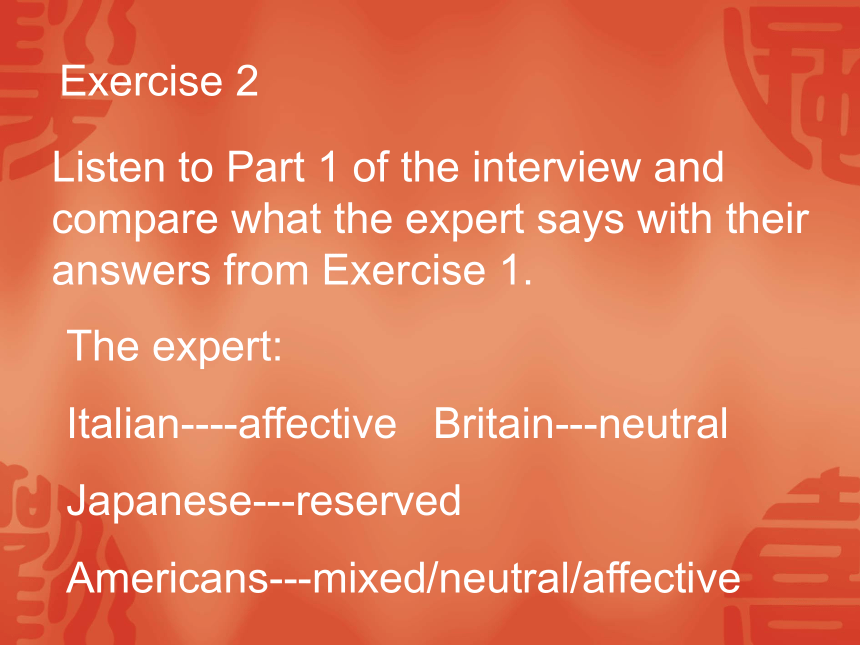
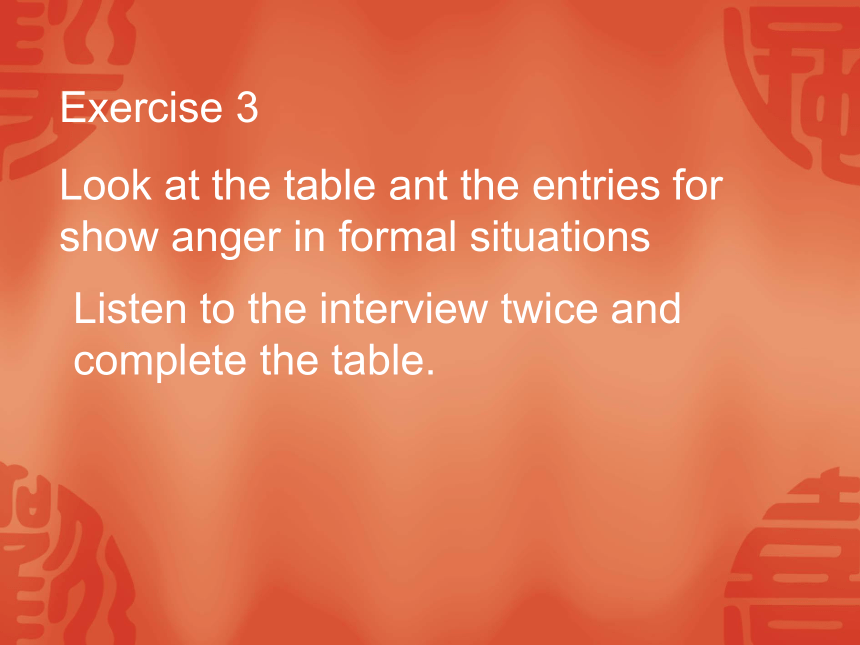
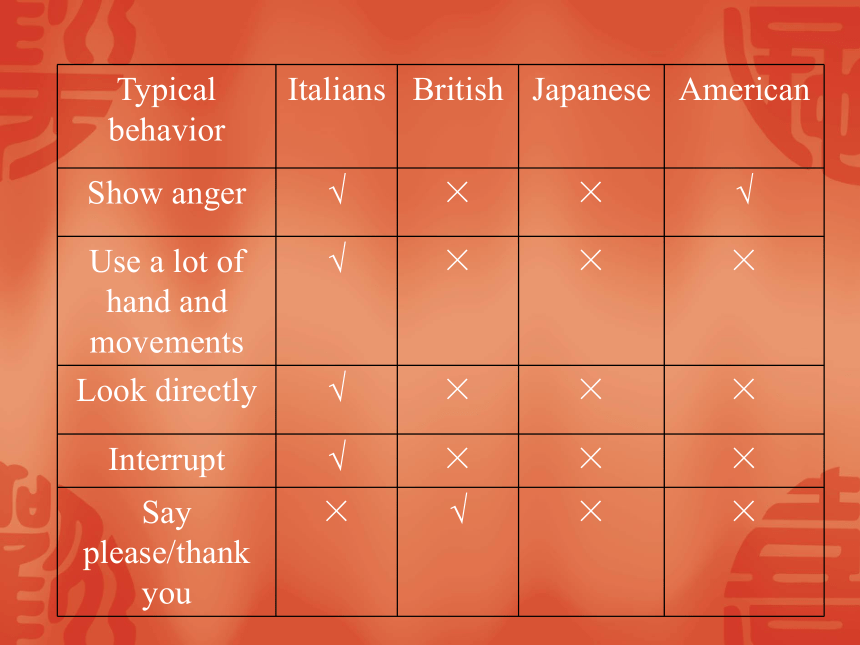
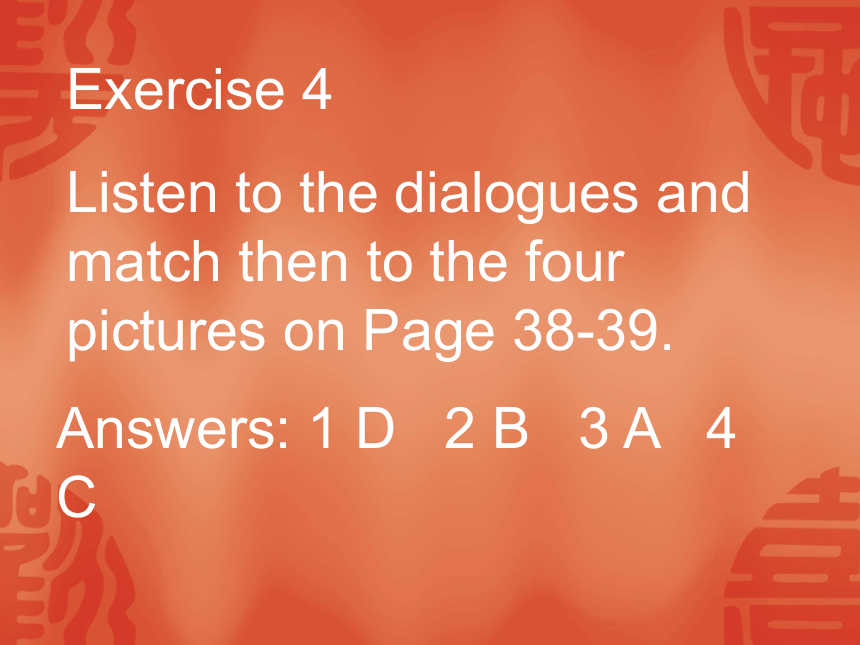
文档简介
(共14张PPT)
Exercise 1
Look at the scale of “degree of showing emotion” and discuss in pairs where you would place people from Italy, Japan, Britain and the USA.
Give reasons for your opinions and to comment on the stereotypes that these nationalities have in China.
Exercise 2
Listen to Part 1 of the interview and compare what the expert says with their answers from Exercise 1.
The expert:
Italian----affective Britain---neutral
Japanese---reserved
Americans---mixed/neutral/affective
Exercise 3
Look at the table ant the entries for show anger in formal situations
Listen to the interview twice and complete the table.
Typical behavior Italians British Japanese American
Show anger √ × × √
Use a lot of hand and movements √ × × ×
Look directly √ × × ×
Interrupt √ × × ×
Say please/thank you × √ × ×
Exercise 4
Listen to the dialogues and match then to the four pictures on Page 38-39.
Answers: 1 D 2 B 3 A 4 C
Listen to the dialogues once again, and complete the Function File.
Answers:
1 please 2 Thank you 3 welcome
4 rather 5 Excuse me 6 could
7 mind 8 kind 9 trouble
10 really sorry 11 promise
Exercise 6
Work in pairs, and make a list of the expressions for the functions a-f.
Listen and repeat the expressions.
a) Excuse me Could you pass the lemon and salt, please
b) You’re welcome.
c) I’d rather not, thanks.
d) Do you think I could have a word with you
Would you mind giving me a lift to school
e) Thanks a lot. That’s very kind of you.
f) Oh, I’ve forgotten it! I’m really sorry.
Exercise 7
Read through the four ways (a-d) of being impolite and rude.
Listen to the first item and find the answer to it.
b
Listen to the other items and match the other reasons for sounding rude with the dialogues.
Answers:
2 d, b 3 a, b 4 c
Speaking Exercise 8
Read the Strategies and think of these things before you start the roleplays.
Act out your roleplays in pairs.
Exercise 9
Do the exercise working individually and then compare your answers in pairs.
Listen to the dialogue and check the answers.
Answers:
1 back 2 off 3 up 4 up 5 on
6 up with
Exercise 10
In pairs, practise the dialogue from Exercise 9. Change the information in italics.
Exercise 1
Look at the scale of “degree of showing emotion” and discuss in pairs where you would place people from Italy, Japan, Britain and the USA.
Give reasons for your opinions and to comment on the stereotypes that these nationalities have in China.
Exercise 2
Listen to Part 1 of the interview and compare what the expert says with their answers from Exercise 1.
The expert:
Italian----affective Britain---neutral
Japanese---reserved
Americans---mixed/neutral/affective
Exercise 3
Look at the table ant the entries for show anger in formal situations
Listen to the interview twice and complete the table.
Typical behavior Italians British Japanese American
Show anger √ × × √
Use a lot of hand and movements √ × × ×
Look directly √ × × ×
Interrupt √ × × ×
Say please/thank you × √ × ×
Exercise 4
Listen to the dialogues and match then to the four pictures on Page 38-39.
Answers: 1 D 2 B 3 A 4 C
Listen to the dialogues once again, and complete the Function File.
Answers:
1 please 2 Thank you 3 welcome
4 rather 5 Excuse me 6 could
7 mind 8 kind 9 trouble
10 really sorry 11 promise
Exercise 6
Work in pairs, and make a list of the expressions for the functions a-f.
Listen and repeat the expressions.
a) Excuse me Could you pass the lemon and salt, please
b) You’re welcome.
c) I’d rather not, thanks.
d) Do you think I could have a word with you
Would you mind giving me a lift to school
e) Thanks a lot. That’s very kind of you.
f) Oh, I’ve forgotten it! I’m really sorry.
Exercise 7
Read through the four ways (a-d) of being impolite and rude.
Listen to the first item and find the answer to it.
b
Listen to the other items and match the other reasons for sounding rude with the dialogues.
Answers:
2 d, b 3 a, b 4 c
Speaking Exercise 8
Read the Strategies and think of these things before you start the roleplays.
Act out your roleplays in pairs.
Exercise 9
Do the exercise working individually and then compare your answers in pairs.
Listen to the dialogue and check the answers.
Answers:
1 back 2 off 3 up 4 up 5 on
6 up with
Exercise 10
In pairs, practise the dialogue from Exercise 9. Change the information in italics.
